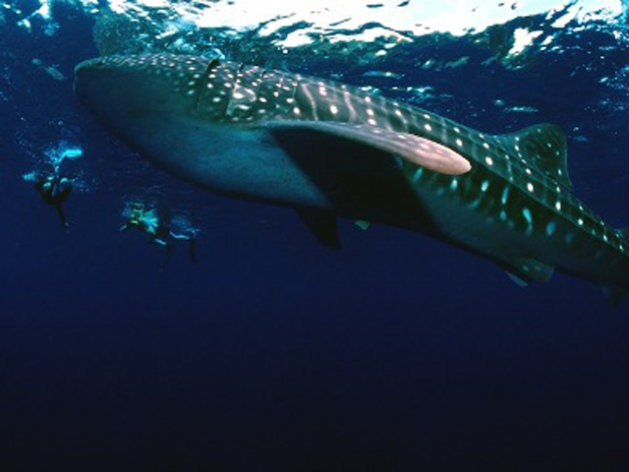"Spectacular" PH wildlife fascinates NatGeo host
Manila Bulletin
15 June 2013

loQal - yahoo-apr17-story1-butandingSS
Manila, Philippines --- He has been to 70 countries looking for
"dangerous" wildlife liaisons for the last 20 years. Dr. Brady Barr, a National
Geographic (NatGeo) Channel Asia TV host and ambassador, had been face-to-face
with the wildest and most dangerous animal, as he goes around the world to raise
awareness on wildlife conservation. But one of his biggest wishes is to see a
whale shark, locally called in the Philippines as "butanding."
"I am interacting with everything from giant squid to polar bears to electric eels, elephants, platypus, you name it. But I have never seen a whale shark. That's on top of my list. I will come back here and experience the whale shark," Dr. Barr told this reporter.
The whale shark (Rhincodon typus) is the world's largest living fish species, classified as "vulnerable" by the International Union for the Conservation of Nature (IUCN). During peak season, Donsol in Sorsogon is one of the best places to see whale sharks.
Aside from whale shark, Dr. Barr also hopes to see other species of animals that thrive in the Philippines.
"You've got spectacular animals, giant beautiful eagles and endemic crocodiles. I've never seen a pangolin (and) you got an endemic species of pangolin. You've got the world's smallest species of primate, the tarsier, which I have never seen. You've got all of these special stuff," he said.
"These are set in a spectacular and beautiful landscape. Filipinos are nice and friendly, they make me feel at home so all that adds up to a great situation and I will definitely come back," he added.
Dr. Barr expressed enthusiasm that the National Geographic Channel will be able to produce new documentaries in the future to "introduce what we're talking about to the entire world and the beauty of the Philippines."
"I like unspoiled, natural places almost unexplored. In the Philippines, there are so many islands. And there are so many areas that look just like a thousand years ago. You don't have this crash of humanity like you do in some other Asian countries and that's not only special to me but it's a special place for all these animals we are talking about," he said.
As a herpetologist, an expert on amphibians and reptiles, Dr. Barr had a quick trip to Palawan to "meet" a giant saltwater crocodile (Crocodylus porosus) named 'Surigao' last June 12.
"I raise awareness for conservation issue as ambassador of the National Geographic. And talk about reptiles in general and dispel any myths or misconceptions, like crocodiles. Crocodiles are not these blood-thirsty monsters that will just going to attack and kill you. They are important, intelligent animals that need to be protected," he explained.
"We heard about a large crocodile that might be a record. That piqued my interest and I actually want to see this crocodile so that pretty much taken much of our time. Looked around and quickly investigated this crocodile," he said.
"It was a great experience because you don't see giant crocodiles more often. The Philippines is blessed with many giant crocodiles. This is a special place for giant crocodiles, I don't know why. It isn't bigger than 'Lolong,' it isn't bigger than the one in captivity in Australia, Cassius. But it (Surigao) is still five and a half meters long, probably weighs a ton and it's a beautiful specimen. It wasn't as big as 'Lolong,' but it was a magnificent animal," he added. "It's amazing that both Lolong and Surigao were found in the Philippines. The country should take pride in its rich wildlife and consider it a national treasure, as well as take steps to conserve it."
Lolong, also a saltwater crocodile, used to be the largest living crocodile in captivity in the world, before its death last February 10. It was held captive for 18 months in an eco-tourism park in Bunawan town in Agusan del Sur since its capture in September 2011 at the Agusan Marsh. It officially measures 6.17 meters or 20.24 feet. However, the record as "world's biggest living crocodile in captivity" was reverted to 'Cassius,' which measures 5.84 meters or about 19 feet.
Dr. Barr describes crocodile species in the Philippines that "get larger than other species of crocodiles."
"There are 23 different types of crocodiles in the world but this is the biggest. Here in the Philippines you have two species. One is the Philippine crocodile, which is found nowhere else in the world. It is a very special animal but it is critically endangered and then you have the saltwater crocodile, which is found all over Southeast Asia which gets giant, enormous sizes, you can find it swimming a hundred kilometers swimming into the open ocean, it's a big animal and it travels," he said.
The expert has also expressed his view on Lolong. "I don't know how the government handled the animal but I know that it died. If you have a crocodile deemed a nuisance or problem crocodile, one that attacks people, has killed livestock or threatened children, then it's a dangerous animal. You have two options: You kill the animal or you have to put it in captivity. But it is a crime to kill an animal that big something that is 70, 80 or a hundred years old. It is better to put it in captivity," he said.
"I think they (government) did the right thing by putting it in captivity. Because then it becomes an ambassador for species, to raise awareness, to let people get close and personal, to see the beauty and majesty of a species like this. It's a tragedy that it died. But I think their hearts where in the right place trying to keep it alive in captivity when the alternative was just to kill it, sink it in the river and no one will see it," he added.

No comments:
Post a Comment